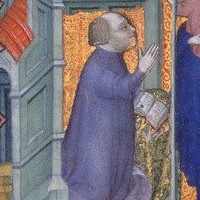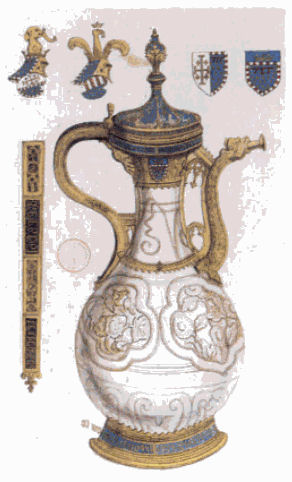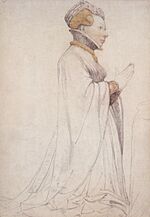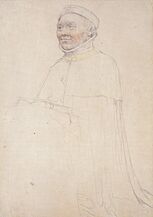John, Duke of Berry facts for kids
Quick facts for kids John |
|
|---|---|
| Duke of Berry | |
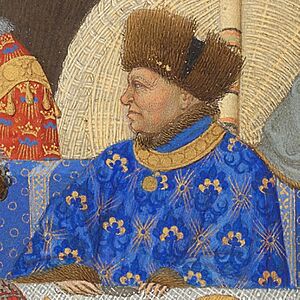
Image of John, Duke of Berry from the Très Riches Heures
|
|
| Regent of France | |
| Regency | 1382-1388 |
| Monarch | Charles VI |
| Co-Regent | Philippe II, Duke of Burgundy (1382-1388) Louis II, Duke of Bourbon (1382-1388) |
| Born | 30 November 1340 Château de Vincennes |
| Died | 15 June 1416 (aged 75) Paris |
| Spouse | Joan of Armagnac Joan II, Countess of Auvergne |
| Issue | Jean de Valois, Count of Montpensier Bonne, Viscountess of Carlat Marie, Duchess of Auvergne |
| House | Valois |
| Father | John II of France |
| Mother | Bonne of Bohemia |
John of Berry (born 30 November 1340 – died 15 June 1416) was a powerful French prince. He was the Duke of Berry and Auvergne, and also the Count of Poitiers and Montpensier. His brothers included King Charles V of France and Philip the Bold, Duke of Burgundy.
John is best known today for his amazing collection of illuminated manuscripts and other artworks. These were special books with beautiful drawings and decorations. One of his most famous commissions was the Très Riches Heures. His personal motto was Le temps venra, which means "the time will come."
Contents
Early Life and Royal Duties
John was born at the Château de Vincennes in France on November 30, 1340. He was the third son of King John II of France and Bonne of Luxembourg.
In 1356, his father made him the Count of Poitou. Two years later, in 1358, he became the king's special representative, called a "lieutenant," in several regions. This meant he helped manage these areas while his father was held captive by the English.
In 1360, a peace treaty meant that Poitiers was given to England. So, John's father gave him new titles: Duke of Berry and Auvergne. As part of the treaty, John had to go to England as a "hostage" until 1369. This meant he stayed there to ensure the treaty was followed. When he returned to France, his brother, King Charles V, gave him even more important roles across many regions.
Serving as a Regent
When his older brother, King Charles V, died in 1380, his son Charles VI was still very young. Because the new king was a "minor" (too young to rule on his own), John and his brothers, along with the Duke of Bourbon, became "regents." A regent is someone who rules a country when the king or queen is too young or unable to do so.
John was also put in charge of Languedoc, a region in southern France. Here, he had to deal with a peasant uprising called the Harelle. This revolt happened because people were angry about high taxes needed to pay for the war against England.
After his brother Louis of Anjou died in 1384, John and his brother, the Duke of Burgundy, became the most powerful figures in France. However, in 1388, King Charles VI decided he was old enough to rule. He took back power and gave control to his father's old advisors. These advisors were political rivals of John and his uncles. John also lost his position in Languedoc.
John and the Duke of Burgundy waited for their chance. They regained power in 1392 when King Charles VI had his first mental health crisis. This illness would affect the king for the rest of his life.
In the 1390s, John and the Duke of Burgundy often competed for the king's favor against the Duke of Orléans, who was Charles VI's brother. In 1401, John managed to get the king to sign over control of Languedoc, Berry, Auvergne, and Poitou back to him.
John also worked with a church leader named Simon of Cramaud. They tried to find a way to end the Great Western schism, which was a time when there were multiple popes, causing a big split in the Christian church.
Later Years and Peacemaking
In his later life, John became known for trying to bring peace to France. After his brother Philip the Bold died in 1404, John was the last living son of King John II. He often tried to make peace between his nephews, Louis of Orléans and John the Fearless. These two were leading different sides in a civil war in France.
After the Duke of Orléans was murdered by order of the Duke of Burgundy, John generally supported the Orléanist side. However, he always tried to be a moderate figure, working to bring the two sides together and promote peace within the country.
It was largely because of John's strong advice that King Charles VI and his sons were not present at the Battle of Agincourt in 1415. John remembered what happened to his own father, who was captured by the English after the Battle of Poitiers many years before. He feared that if the king and his heirs were captured, it would be a disaster for France. His advice saved them from participating in the battle.
John died on June 15, 1416, in Paris. This was just a few months after the Battle of Agincourt, which turned out to be as terrible for France as he had feared.
Family Life
John had several children with his first wife, Joanna of Armagnac (married 1360, died 1387):
- Bonne of Berry (1367–1435), who became Viscountess of Carlat.
- Charles of Berry, Count of Montpensier (1371–1383).
- Jeanne of Berry (1373–1375).
- Beatrice of Berry (born April 1374).
- Marie of Berry (1375–1434), who became Duchess of Auvergne.
- John de Valois, Count of Montpensier (1375/1376–1397).
- Louis of Berry (1383, died young).
In 1389, John married his second wife, Joan II, Countess of Auvergne (born around 1378, died 1424).
A Great Art Patron
John of Berry was a very important patron of the arts. A patron is someone who supports artists and pays them to create works. He commissioned many famous pieces, including the most well-known Book of Hours, the Très Riches Heures. A Book of Hours was a type of prayer book, often beautifully decorated.
This book, like other works made for the Duke, showed the artistic styles of the time. It combined the realistic style from Flanders, the elegant Parisian style, and Italian painting techniques. John loved illuminated manuscripts, which are books with detailed drawings and decorations. He hired many famous artists, such as the Limbourg Brothers, Jacquemart de Hesdin, and André Beauneveu. His interest in art helped many talented miniature painters become successful.
However, John's spending on his art collection was very expensive. He was deeply in debt when he died in Paris in 1416.
Other famous works created for him include the Belles Heures of Jean de France, Duc de Berry and parts of the Turin-Milan Hours. He also owned beautiful gold objects like the Holy Thorn Reliquary and the Royal Gold Cup, which are now in the British Museum.
The Louvre museum's website says that John of Berry, with his refined taste and constant search for artists, greatly helped the art world grow and change during his time.
See also
 In Spanish: Juan I de Berry para niños
In Spanish: Juan I de Berry para niños



